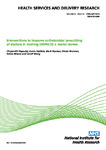Interventions to improve antimicrobial prescribing of doctors in training (IMPACT): a realist review
| dc.contributor.author | Papoutsi, Chrysanthi | |
| dc.contributor.author | Mattick, Karen | |
| dc.contributor.author | Pearson, Mark | |
| dc.contributor.author | Brennan, Nicola | |
| dc.contributor.author | Briscoe, Simon | |
| dc.contributor.author | Wong, Geoff | |
| dc.date.accessioned | 2021-08-09T15:37:59Z | |
| dc.date.available | 2021-08-09T15:37:59Z | |
| dc.date.issued | 2018-03 | |
| dc.identifier.issn | 2050-4349 | |
| dc.identifier.issn | 2050-4357 | |
| dc.identifier.uri | http://hdl.handle.net/10026.1/17520 | |
| dc.description.abstract |
<jats:sec id="abs1-1"><jats:title>Background</jats:title><jats:p>Interventions to improve the antimicrobial prescribing practices of doctors have been implemented widely to curtail the emergence and spread of antimicrobial resistance, but have been met with varying levels of success.</jats:p></jats:sec><jats:sec id="abs1-2"><jats:title>Objectives</jats:title><jats:p>This study aimed to generate an in-depth understanding of how antimicrobial prescribing interventions ‘work’ (or do not work) for doctors in training by taking into account the wider context in which prescribing decisions are enacted.</jats:p></jats:sec><jats:sec id="abs1-3"><jats:title>Design</jats:title><jats:p>The review followed a realist approach to evidence synthesis, which uses an interpretive, theory-driven analysis of qualitative, quantitative and mixed-methods data from relevant studies.</jats:p></jats:sec><jats:sec id="abs1-4"><jats:title>Setting</jats:title><jats:p>Primary and secondary care.</jats:p></jats:sec><jats:sec id="abs1-5"><jats:title>Participants</jats:title><jats:p>Not applicable.</jats:p></jats:sec><jats:sec id="abs1-6"><jats:title>Interventions</jats:title><jats:p>Studies related to antimicrobial prescribing for doctors in training.</jats:p></jats:sec><jats:sec id="abs1-7"><jats:title>Main outcome measures</jats:title><jats:p>Not applicable.</jats:p></jats:sec><jats:sec id="abs1-8"><jats:title>Data sources</jats:title><jats:p>EMBASE (via Ovid), MEDLINE (via Ovid), MEDLINE In-Process & Other Non-Indexed Citations (via Ovid), PsycINFO (via Ovid), Web of Science core collection limited to Science Citation Index Expanded (SCIE) and Conference Proceedings Citation Index – Science (CPCI-S) (via Thomson Reuters), Cochrane Central Register of Controlled Trials (CENTRAL), Cochrane Database of Systematic Reviews, the Health Technology Assessment (HTA) database (all via The Cochrane Library), Applied Social Sciences Index and Abstracts (ASSIA) (via ProQuest), Google Scholar (Google Inc., Mountain View, CA, USA) and expert recommendations.</jats:p></jats:sec><jats:sec id="abs1-9"><jats:title>Review methods</jats:title><jats:p>Clearly bounded searches of electronic databases were supplemented by citation tracking and grey literature. Following quality standards for realist reviews, the retrieved articles were systematically screened and iteratively analysed to develop theoretically driven explanations. A programme theory was produced with input from a stakeholder group consisting of practitioners and patient representatives.</jats:p></jats:sec><jats:sec id="abs1-10"><jats:title>Results</jats:title><jats:p>A total of 131 articles were included. The overarching programme theory developed from the analysis of these articles explains how and why doctors in training decide to passively comply with or actively follow (1) seniors’ prescribing habits, (2) the way seniors take into account prescribing aids and seek the views of other health professionals and (3) the way seniors negotiate patient expectations. The programme theory also explains what drives willingness or reluctance to ask questions about antimicrobial prescribing or to challenge the decisions made by seniors. The review outlines how these outcomes result from complex inter-relationships between the contexts of practice doctors in training are embedded in (hierarchical relationships, powerful prescribing norms, unclear roles and responsibilities, implicit expectations about knowledge levels and application in practice) and the mechanisms triggered in these contexts (fear of criticism and individual responsibility, reputation management, position in the clinical team and appearing competent). Drawing on these findings, we set out explicit recommendations for optimal tailoring, design and implementation of antimicrobial prescribing interventions targeted at doctors in training.</jats:p></jats:sec><jats:sec id="abs1-11"><jats:title>Limitations</jats:title><jats:p>Most articles included in the review discussed hospital-based, rather than primary, care. In cases when few data were available to fully capture all the nuances between context, mechanisms and outcomes, we have been explicit about the strength of our arguments.</jats:p></jats:sec><jats:sec id="abs1-12"><jats:title>Conclusions</jats:title><jats:p>This review contributes to our understanding of how antimicrobial prescribing interventions for doctors in training can be better embedded in the hierarchical and interprofessional dynamics of different health-care settings.</jats:p></jats:sec><jats:sec id="abs1-13"><jats:title>Future work</jats:title><jats:p>More work is required to understand how interprofessional support for doctors in training can contribute to appropriate prescribing in the context of hierarchical dynamics.</jats:p></jats:sec><jats:sec id="abs1-14"><jats:title>Study registration</jats:title><jats:p>This study is registered as PROSPERO CRD42015017802.</jats:p></jats:sec><jats:sec id="abs1-15"><jats:title>Funding</jats:title><jats:p>The National Institute for Health Research Health Services and Delivery Research programme.</jats:p></jats:sec> | |
| dc.format.extent | 1-136 | |
| dc.language | en | |
| dc.language.iso | en | |
| dc.publisher | National Institute for Health and Care Research | |
| dc.subject | Clinical Research | |
| dc.subject | 7.3 Management and decision making | |
| dc.subject | 8.1 Organisation and delivery of services | |
| dc.subject | Generic health relevance | |
| dc.title | Interventions to improve antimicrobial prescribing of doctors in training (IMPACT): a realist review | |
| dc.type | journal-article | |
| dc.type | Review | |
| plymouth.issue | 10 | |
| plymouth.volume | 6 | |
| plymouth.publication-status | Published online | |
| plymouth.journal | Health Services and Delivery Research | |
| dc.identifier.doi | 10.3310/hsdr06100 | |
| plymouth.organisational-group | /Plymouth | |
| plymouth.organisational-group | /Plymouth/Faculty of Health | |
| plymouth.organisational-group | /Plymouth/Faculty of Health/Peninsula Medical School | |
| plymouth.organisational-group | /Plymouth/REF 2021 Researchers by UoA | |
| plymouth.organisational-group | /Plymouth/REF 2021 Researchers by UoA/UoA23 Education | |
| plymouth.organisational-group | /Plymouth/Users by role | |
| plymouth.organisational-group | /Plymouth/Users by role/Academics | |
| dc.identifier.eissn | 2050-4357 | |
| dc.rights.embargoperiod | Not known | |
| rioxxterms.versionofrecord | 10.3310/hsdr06100 | |
| rioxxterms.licenseref.uri | http://www.rioxx.net/licenses/all-rights-reserved | |
| rioxxterms.type | Journal Article/Review |


